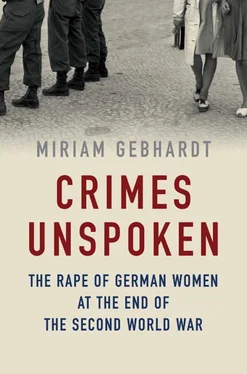Fears waxed and waned, depending on the military situation. The mood improved if British or American troops were to be expected. On 10 April, the chaplain Oswald Kullmann from Kleinbartloff in Thuringia rejoiced: ‘The Americans are coming! Excitement but no panic; excitement fluctuating between fear and joy, but tending more to joy.’ In June, he wrote: ‘Soon the Russians will be coming. They are preceded by rumours of atrocities, filling the population with new dread.’ Thirty inhabitants fled – with good reason, as it turned out. At the end of June, the Americans handed over Kleinbartloff to the Soviets, and in early July there were reports that nine Russians and Poles had broken into a farm at Ober-Orschel and raped the women living there. [8] Kriegsende und Neubeginn in Landkreis Eichsfeld 1945/1946 (Heiligenstadt 2003), p. 267.
Soviet soldiers held the most fear for the Germans. They were regarded as being unpredictable and so brutalized that they would not stop short of defiling children, old people and nuns, or even their own compatriots, such as the Soviet women working as slave labourers. The greatest fear was inspired by the ‘Mongols’ or ‘Asiatics’, soldiers from the eastern regions of the Soviet Union. They were followed by the French, particularly the dark-skinned colonial troops from Algeria, Tunisia and Morocco, who had a notorious reputation, recalling the mood after the First World War and the ‘Black Shame’ on the Rhine. [9] The rumours at the time went in both directions. The colonial soldiers were said to lust violently after German women, and German women to fraternize immorally with the enemy; see Christian Koller, ‘Feind – Bilder: Rassen und Geschlechterstereotype in der Kolonialtruppendiskussion Deutschlands und Frankreichs, 1914–1923’, in: Karen Hagemann, Ralf Pröve and Stefanie Schüler-Springorum (eds.), Heimat-Front: Militär und Geschlechterverhältnisse im Zeitalter der Weltkriege (Frankfurt 2002), pp. 150–67.
Among the Americans, the blacks or ‘negroes’ instilled fear and terror long before their arrival. The darker the skin and the more unfamiliar the physiognomy, the more threatening the soldiers appeared. This racial prejudice applied particularly to Africans and Mongols, who were reputed to be brutal rapists and generally regarded as being uncivilized with uncontrollable urges.
Feeding on the mixture of racial prejudice and propaganda, stories and rumours of atrocities committed by German troops in the East further exacerbated the fears within the civilian population. The greatest fear was that the Red Army would retaliate by committing similar atrocities. It prompted people in the East to abandon house and home, livestock and most of their possessions to escape from the approaching Soviets. But in Berlin as well, and everywhere else where the Russians were coming, Nazi propaganda and the fear of Communism meant that the spectre of bloodthirsty Soviet beasts, Asiatic hordes and Russian barbarians spread like wildfire.
The external appearance of these foreigners was already enough to cause anxiety. The occupiers came from all over the Soviet Union and spoke so many languages and dialects that even the officers sometimes had difficulty in communicating with their units. They were Russians, Byelorussians, Ukrainians, Caucasians, Georgians and Kazakhs, Armenians and Azerbaijanis, Bashkirs, Moldovans, Tatars, inhabitants of Irkutsk, Uzbeks and more, but in the perception of the indoctrinated German society this ethnic mosaic was reduced to ‘Mongols’, ‘Cossacks’ and ‘Asiatics’. They were considered to be much less civilized than the Germans, and also Germany’s other enemies. The first impression tended to confirm this belief. Unlike the Americans in their trucks and jeeps, the Soviets arrived by means of transport that were anything but impressive: motorcycles, horses, carts or simply on foot.
Escape through suicide
A particularly radical consequence of this ideologically fomented panic is illustrated by a story from Holzendorf-Mümmeldorf, a hitherto insignificant village halfway between Brüel and Criwitz in Mecklenburg. It had two farmsteads and a tenant farm owned by the church, with a lake to the west. When the first Red Army soldiers were sighted near the village on 4 May 1945 and reports began to circulate that some women had been raped, three inhabitants – the shepherd Martin Bründel from Müsseldorf, his father-in-law Christian Kunst and the tenant of the farm owned by the church – decided that they would not suffer the same fate. On 6 May, Bründel took his family down to the lake, where he cut the throat first of his twelve-year-old daughter Hannelore and then of his wife. The ten-year-old son Herbert and six-year-old daughter Helga, who tried to run away, were held back by their grandparents.
Their father beat them to death with a club and then proceeded to drown the two-year-old Hans. Then Kunst beat his wife to death. The two men abandoned their original plan of committing suicide themselves. Instead they made it look as if the women and children had been brutally raped and murdered by the Soviets. And it didn’t end there: on the same afternoon the tenant shot his wife, daughter-in-law and himself. Bründel remarried after the war and became a member of the SED (East German Communist party). The deception was not discovered until 1962. Bründel and Kunst admitted that they had attempted to place the blame for the murders on the Soviets. They were both sentenced to death and executed. [10] Kurt Redmer, Die letzten und die ersten Tage: Dokumentation über Geschehnisse in Mecklenburg im 2. Weltkrieg und danach (Schwerin 2007), pp. 121–8.
Even if this is a particularly drastic example of the panic and ideological delusion of the Germans, there are eyewitness reports hinting at large-scale suicides, even a ‘suicide epidemic’. [11] Goeschel, Selbstmord im Dritten Reich , p. 241.
Women in particular committed suicide to escape the feared rape and shame of falling victim to foreign soldiers. Even practising Christians were convinced that suicide was preferable to ‘defilement’ – by ‘subhumans’ into the bargain. [12] Ibid.
The Führer and his entourage had already set the example of committing suicide for fear of falling into the hands of the enemy. Among the high-up Nazis, and also in the population at large, it took on epidemic proportions. The women close to Hitler – Eva Braun and Magda Goebbels – led the way. Goebbels’ wife is thought to have killed her six youngest children herself as the only honourable end to the Nazi regime. It is therefore highly probable that many normal Germans also committed suicide, not only from fear of the Soviets but also because a life without National Socialism had no more meaning for them. Added to that was the idea of capitulation and the shame it represented, both individually and collectively. In the eyes of staunch Nazis, capitulation and flight were the worst disgrace. And what would be a more obvious symbol of capitulation than rape by a Red Army soldier?
Hitler had demanded total defeat and the complete destruction of Germany. He believed that it was more honourable to die a ‘soldier’s death’ than to negotiate for peace, much less to surrender. The Nero Decree of 19 March 1945 ordered the destruction of the infrastructure in the belief that the enemy would in any case be completely ruthless. Seen in this way, suicide was an act not of cowardice but of self-sacrifice to thwart the enemy one last time.
Many women carried cyanide capsules and razor blades in their handbags. In April 1945, suicides in Berlin peaked at 3,881 cases, or 242.7 per 100,000 inhabitants, five times higher than in the years before. In 1945, there were 7,057 officially recorded cases of suicide for the whole of Germany; in reality the figure was probably higher. There were 42 cases in the devoutly Catholic region of Upper Bavaria between April and May 1945, compared with just 3 to 5 in previous years. [13] Albin Segmüller, Über reactive Selbstmorde und Selbstmordversuche in der Nachkriegszeit (Nuremberg 1949).
Читать дальше











